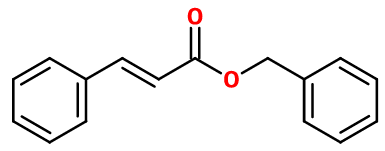Benzyl Cinnamate
Naturelle - Synthétique
Balsamic Ambery > Balsamic > White Flowers > Cinnamic

Crédits photo: ScenTree SAS
Other names :
Benzyl 3-Phenylprop-2-enoate ; Benzyl 3-phenyl propenoate ; Benzyl alcohol cinnamate ; Benzyl gamma-phenyl acrylate ; Benzyl-3-phenyl propenoate ; Cinnamein ; Phenyl methyl 3-phenyl-2-propenoate ; Phenylmethyl 3-phenylprop-2-enoate
Volatility :
Heart/Base
Uses in perfumery :
Benzyl Cinnamate is used mainly in oriental perfumes as a fixative note. Used in heavy fragrances, reproducing notes of vanillic tree resin.
Natural availability :
Benzyl Cinnamate is found in Peru Balsam Resinoid and in Tolu Balsam Resinoid as well as in Copahu EO or Cabreuva EO, among others. Therefore, natural Benzyl Cinnamate can be extracted from these balsams and essential oils.
Year of discovery :
Data not available.
Other comments :
Benzyl Cinnamate is one of the 26 allergens in perfumery.
Price Range :
€€
Stability :
May form Cinnamic Acid through time.
Tends to get a yellow color through time.
Tends to get a yellow color through time.

Crédits photo: ScenTree SAS
- Molecular formula :
- C16H14O2
- Molecular Weight :
- 238,29 g/mol
- Density :
- 1,1
- Flash Point :
- 180°C
- Fusion Point :
- 34°C
- Appearance :
- White to pale yellow solid
- Log P :
- 4,1
- Boiling Point :
- 350°C
- Detection Threshold :
- Donnée indisponible.
Synthesis route :
Benzyl Cinnamate is synthesized by an esterification reaction, using Cinnamic Acid, Benzyl Alcohol and an acidic catalyst such as sulfuric acid.
Synthesis precursor :
Benzyl CInnamate is not a precursor to the synthesis of another compound of olfactory interest.
Isomerism :
Benzyl Cinnamate has a double bond allowing the existence of two diastereoisomers (Z) and (E) which have a similar smell.
- EINECS number :
- 203-109-3
- FEMA number :
- 2142
- JECFA number :
- 670
- FLAVIS number :
- 09.738
- Allergens :
- Benzyl Cinnamate may provoke an allergic reaction on skin contact (redness, heat, scraching, prickling) for some people.
- IFRA :
- This ingredient is restricted by IFRA
- Restriction type :
- RESTRICTION
- Cause of restriction :
- DERMAL SENSITIZATION AND SYSTEMIC TOXICITY
- Amendment :
- 49
- Quantitative limit on the use :
-
Cat.1 Cat.2 Cat.3 Cat.4 Cat.5A Cat.5B Cat.5C Cat.5D Cat.6 0,36 % 0,11 % 1,2 % 2 % 0,51 % 0,51 % 0,51 % 0,17 % 1,2 % Cat.7A Cat.7B Cat.8 Cat.9 Cat.10A Cat.10B Cat.11A Cat.11B Cat.12 2,4 % 2,4 % 0,17 % 3,9 % 3,9 % 14 % 0,17 % 0,17 % No Restriction - Restriction type :
- RESTRICTION QRA
- Cause of restriction :
- SENSITIZATION
- Amendment :
- 42
- Quantitative usage limits :
-
Cat.1 Cat.2 Cat.3 Cat.4 Cat.5 Cat.6 Cat.7 Cat.8 Cat.9 Cat.10 Cat.11 0,1 % 0,2 % 0,7 % 2,1 % 1,1 % 3,4 % 0,4 % 2 % 5 % 2,5 % Not Restricted
To learn more about IFRA's standards : https://ifrafragrance.org/safe-use/library
ScenTree is solely responsible for the information provided here.

